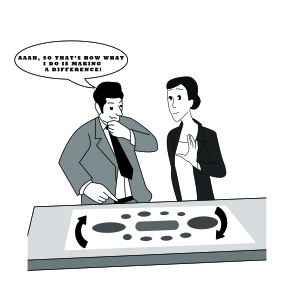A young female relative of mine is amazing. In her early 20s she has been challenging her mindset and creating more of the life she desires. At 22 she had been a factory worker for 6 years. So much for Gen Y not staying with an employer!
But she hated her work. Everyday the same thing. Pull this lever, push that lever. Time moved so slowly she could hear the ‘tick tock’ of the clock above the noise of the machinery!
She wanted to quick. But what to do?
We had a chat. She mentioned that she had wanted to try some office work.
“What if you went and did some formal education, maybe starting with a Certificate II in Business Administration or something like that. Maybe you could then make the move off the factory floor.”
“I’m a terrible student. I can’t study!“, was her reply.
Aaaah mindsets, they kick in very quickly when the unfamiliar is mentioned.
“What do you want?” I asked.
“To get off the factory floor and to never have to look at a machine again! But I don’t know anything else!“
“Which is why going back to some form of school will help. How else will you get away from factory work and get another type of job?” I queried.
“Maybe I should give it a go. But my employer won’t help me. They have never given me any proper training.“
“What if you were to ask them? What’s the worst they can say?”
“No!“.
She went ahead and asked about support for some training. She even shared her desire to move off the factory floor. “No!” was the response she received and she was also told that she was, “Needed on the factory floor.” Yes, after 6 years she knew a thing or two about the machines.
Can you imagine her reaction to her employer’s negativity? “I’ll never get out of here. I need the money so I can’t quit. I’m stuck.” Mindsets are hard to shift and having an employer like hers made it even harder.
“What do you want?” I prodded.
“To get off the factory floor.” was her response.
“What can you do to make that happen?” I probed.
“Go back to school outside work.” she responded.
We discovered that she could do her course online and that due to government support it was far cheaper than expected. She completed her Certificate II in Business Administration. It might not sound like much but it was a monumental effort and moment.
She asked for a trial in the office.
“No” was the response. “We need you on the factory floor.” Apparently it was an honour to be employed by this employer and she should be grateful for the job she had. No need for self improvement around here!
“See, what was the point!” she exclaimed to me. “I’ll never leave here!“
“What do you want?” I asked.
“To get off the factory floor.” she responded.
“What are you going to do now?” I probed, yet again.
“Maybe I should do another course?” she suggested.
“Maybe you should. You have now proved that you can finish a course. Why not go to the next level and see what happens?”
“Okay. I’ll give it a go.” Her mindset had shifted. The power of evidence and movement was working.
She completed her Certificate III in Business Administration. She approached her employer about doing a trial in the office. “No! We need you on the factory floor.”
She signed up with an employee agency. She got offered a job as a clerk in a small company on less money than she was earning on the factory floor.
What do you think she did?
She quit her factory job. Aaah, to have been a fly on the wall and seen the look on her employer’s face…”but, but we need you on the factory floor!”. Well, yes you probably do. But an employer – employee relationship is a two way street. If they had given her a go in the office and supported her development, she’d probably be there today. But she’s not.
Moving away from what you don’t want can be a major motivator for getting you to take action, even if it may appear to be a backward step in order to create what you do want.It also takes bravery and courage. I’m proud of my young relative (can you tell?)!
Stay tuned for Part 2 of this mindset shifting saga where I will share more of the ups and downs of this major mindset shift that has, and is occurring in my relative.
Oh, and if you think the lack of her employer’s support in the story so far is mind-boggling, wait until you read Part 2… and the even greater challenges she has had with shifting her mindset from one of being out of control of her life to being in control of her life.
Visit Gary at http://garyryans.com

